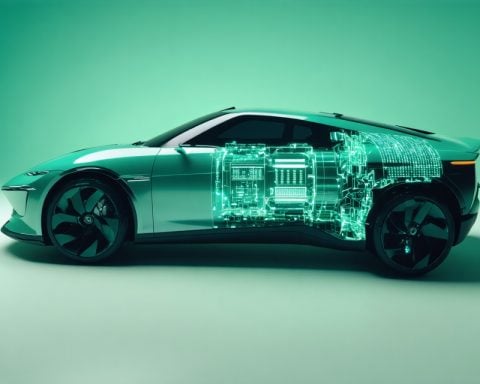- Tesla’s entry into India has caused temporary market disruptions, impacting Mahindra & Mahindra and Tata Motors’ shares.
- Analysts view this as a short-term overreaction, predicting market stabilization similar to global trends when new players enter.
- Tesla’s high pricing poses a challenge in India’s cost-sensitive automotive market, where local brands excel with affordable technology.
- The introduction of Tesla may spur local electric vehicle (EV) development, potentially leading to an enhanced EV ecosystem in India.
- Instead of posing a threat, Tesla’s presence could catalyze growth and innovation within the Indian automotive sector.
The stormy arrival of Tesla in India rocked the stock exchanges, sending the shares of Mahindra & Mahindra and Tata Motors into a tailspin. Investors jittered, bracing for the formidable power of the American electric vehicle behemoth. Yet, beneath the market’s ripple, whispers of optimism surfaced. Analysts saw more than just a fierce rival; they glimpsed an opportunity, a catalyst emboldening India’s automotive landscape.
Shares of Indian automakers stumbled as if hit by a sudden financial squall. Mahindra & Mahindra saw a steep decline, and Tata Motors grazed its lowest point in a year. Market pundits, however, urged a ceasefire on panic. This, they argued, was a reflexive overreaction. Observers familiar with global market dynamics noted that the initial turbulence would likely stabilize, echoing patterns observed each time a global giant wades into a new arena.
While Tesla commands awe, its high-end pricing cloaks a competitive edge. The Indian car market, deeply rooted in cost-sensitivity, presents an arena where players like Tata Motors and Mahindra & Mahindra already dance deftly, offering solid technology at accessible prices. Though Tesla’s allure is undeniable, its weights in gold, literally. Yet, its march onto Indian soil heralds not doom but dawn—an invitation for growth.
Tesla’s advent might prove a harbinger of enhanced local EV developments, nudging the industry toward a renaissance. The establishment of a vibrant electric ecosystem blooms on the horizon, as local suppliers prepare to bask in the downstream effects of technological investments.
In this multifaceted saga of automobiles in India, Tesla plays the role of an alchemist rather than an antagonist. The electric tide it heralds promises not just disruption but evolution—a new chapter where homegrown resilience and innovation will continue to flourish.
Is Tesla’s Arrival in India a Catalyst or a Catastrophe for Local Automakers?
How-To Steps & Life Hacks for Investing in the Indian EV Market
1. Research Thoroughly: Before investing in Indian automakers amidst Tesla’s arrival, understand the market dynamics. Evaluate how established companies like Tata Motors and Mahindra & Mahindra are innovating in the EV space.
2. Diversification: Mitigate risks by diversifying your investments across multiple firms within the automotive sector, including parts suppliers who might benefit from increased EV production.
3. Monitor Policy Changes: Keep abreast of government policies regarding EV subsidies and infrastructure development. Policies promoting electric vehicles can boost local automaker stocks.
Real-World Use Cases of Electric Vehicles in India
– Affordable Urban Mobility: Local brands may continue to lead the segment catering to cost-effective urban commuting solutions through models like Tata’s Nexon EV.
– Rural Access Innovations: Tesla’s focus might push local companies to invest in EVs capable of handling rural terrains, a largely untapped market in India.
Reviews & Comparisons of Tesla and Indian Automakers
– Pricing: Tesla operates in the premium market, while Indian automakers emphasize affordability. This difference remains key as Indian consumers tend to prefer budget-friendly options.
– Technology: Tesla boasts cutting-edge technology, but local companies like Tata Motors are making strides in innovation, particularly in battery and charging infrastructure.
Controversies & Limitations
– High Import Duties: Tesla faces challenges with high import duties, which could limit their ability to price competitively compared to local EVs.
– Infrastructure Hurdles: India’s charging infrastructure is still developing, which may hinder rapid adoption of high-end EVs, giving local players time for strategic growth.
Market Forecasts & Industry Trends
– Growth Predictions: The Indian EV market is expected to grow significantly, with reports suggesting compound annual growth rates of over 20% in the next decade.
– Investment Shifts: The inflow of FDI into the EV sector may increase, with Tesla acting as a significant stimulus for this trend.
Security & Sustainability Considerations
– Battery Supply Chains: Local manufacturers might focus on securing sustainable battery supply chains to compete with Tesla’s existing logistics advantages.
– Local Manufacturing: Tesla’s potential establishment of a manufacturing plant in India could drive sustainability through locally sourced materials, reducing costs, and import taxes.
Pros & Cons Overview of Tesla’s Indian Market Entry
Pros:
– Spurs local innovation and technological enhancements.
– Potential boost in FDI and infrastructure development.
– Increased consumer interest in electric vehicles.
Cons:
– Potential short-term stock volatility for Indian automakers.
– Infrastructure challenges for supporting high-end EVs.
Insights & Predictions
– Strategic Alliances: Expect local players to form alliances and technological partnerships to compete effectively.
– Government Incentives: Policymaker initiatives could play a decisive role in shaping the competitive landscape.
Actionable Recommendations
– Invest in Infrastructure: Investors could capitalize on companies developing EV infrastructure like charging stations.
– Stay Informed: Follow industry news and expert analyses to stay ahead of market trends.
– Leverage Tech Advancements: Focus on stocks of companies excelling in EV tech and local manufacturing capabilities.
For more insights on market dynamics and investment strategies, visit Investopedia.
By understanding the market landscape and being mindful of strategic investments, stakeholders can find opportunities amidst Tesla’s ambitious entry into India’s automotive sector.
















